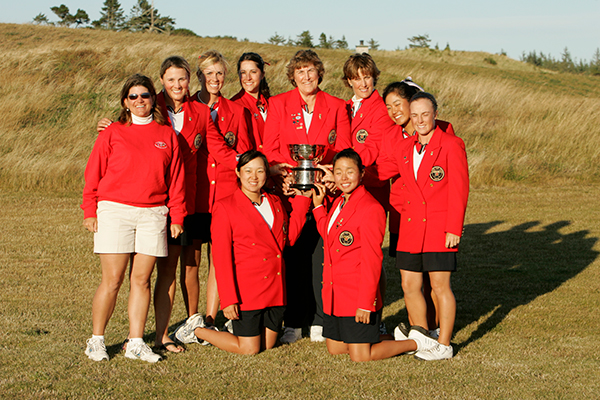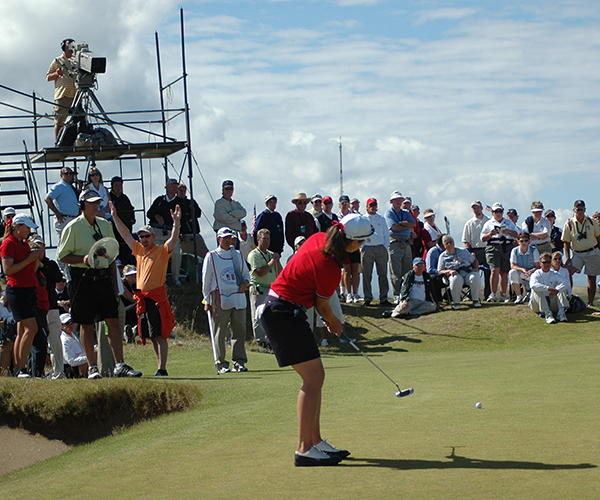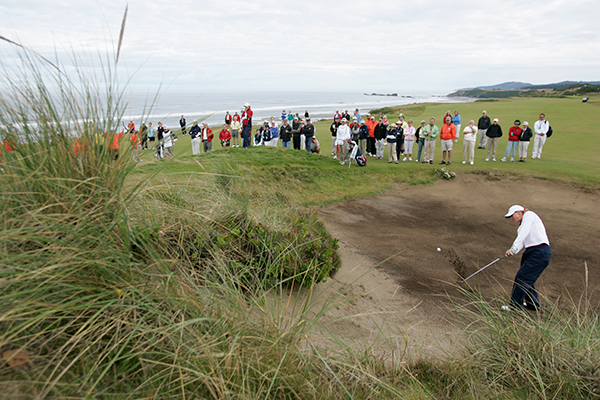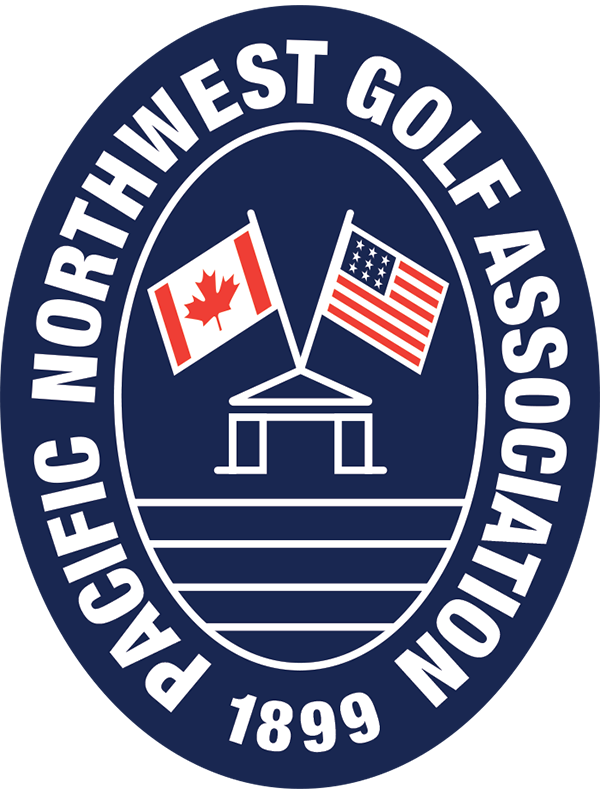Looking Back – Bandon Dunes stages the 2006 Curtis Cup
by Ron Bellamy
Of all things, 13 years later they remember the wind, the way it blew so strongly in the week before the 2006 Curtis Cup, and during the early practice rounds that July.
And then, the way it suddenly didn’t, on the first day of the first USGA championship to be held at Bandon Dunes Golf Resort on the southern Oregon Coast.
“I will never forget opening the blinds that morning and seeing, like, stillness and bright sun and thinking, ‘This is going to be absolutely perfect,’” recalled Paige Mackenzie, then freshly off a superb senior season at the University of Washington and a 23-year-old leader on the U.S. team that would face the team from Great Britain and Ireland in the prestigious international competition for women amateurs.
Without the wind, perceived as a distinct advantage for a GB&I team reared on blustery coastal links courses, things were pretty much perfect for the U.S. team that in the 34th Curtis Cup they thumped the visitors, 11.5 to 6.5, to easily win the two-day event.

And it was pretty much perfect, too, for Bandon Dunes, which successfully hosted the first of what is now five USGA championships, with the 2019 U.S. Amateur Four-Ball scheduled for May 25-29 on the resort’s Pacific Dunes and Old Macdonald courses, and the U.S. Amateur up next in 2020, to be held on the Bandon Dunes and Bandon Trails courses, which will give the resort seven USGA championships in 14 years.
“We knew the golf course would hold up and do a great job,” said Jeff Simonds, then the PGA head professional at Pacific Dunes and now the director of resort operations. “The only question was, ‘Can we provide all the other stuff that makes the Curtis Cup so special?’ – the opening ceremonies, the dinners, the guest speakers.”
Understand that the original Bandon Dunes course had opened just seven years earlier. Pacific Dunes, the Tom Doak-designed course, had opened in 2001, and received tremendous accolades, but five years later the clubhouse was still a temporary facility, a double-wide trailer. As Simonds puts it, a lot of “infrastructure” needed to be put in place.
“It was being creative and thinking outside the box to make sure that when the teams were at the course they could be comfortable and have everything for the championship, even though it was being played at a golf course that really didn’t have a clubhouse,” Simonds said.
“I was still so young and green in the golf industry. I wasn’t smart enough to be as nervous about it as I could have been, or should have been. As we prep for the Four-Ball and the U.S. Amateur, my stress level is certainly higher now than it was then.
“We had a great team, and we were so excited for it. It didn’t matter how much work it took or how many calls we had to make or what we had to do to make it work. Back then there were no hurdles we weren’t willing to run right through.”
As the 2006 event approached, Simonds recalled, the pre-championship debate turned on whether the advantage would fall to the Americans, playing on their home soil, or to the links-savvy squad from overseas. After her first glimpse of Pacific Dunes, Mackenzie, who delayed turning pro that summer specifically to play in the Curtis Cup, figured the challenge would be formidable.
“I was thinking, ‘Why did the USGA select this for the host destination when we’re playing Great Britain and Ireland?’” Mackenzie said. “It felt like nothing I’d ever competed on before. It was like nothing I’d ever seen before.

“When we played all our practice rounds it was very, very windy. I remember Carol Semple Thompson, our captain, trying to teach us all how to hit knock-down shots. Because none of us had ever competed on a golf course like that — windy conditions, firm, fast, fescue.”
From a few glimpses of the visiting team hitting balls on the practice range, it was clear those players had.
“A couple of their players were phenomenal ball strikers,” Mackenzie said. “You could hear it on the range. They were shot-shaping. I just kept thinking, ‘They’ve clearly done this before.’”
But then the wind stopped, and the U.S. team became the gale force, led by Mackenzie. She was riding the wave of an excellent 2005 season and an even better 2006 in which she won the Pac-10 tournament by four strokes, the NCAA West regional by eight and finished eighth in the NCAA championship.
As he recalled memories from the event, Simonds paused, then said, “The only other thing was watching Paige Mackenzie being so confident on a golf course. She had this look about her that she was not going to lose that entire week. She had an unbelievable level of confidence about her golf game everywhere she went.”
Mackenzie went on to an LPGA Tour career, and now is a host for the “Morning Drive,” on Golf Channel, and is scheduled for on-course booth assignments in several events this season, pending the spring delivery of her second child. In the 2006 Curtis Cup, she won both her singles matches, and teamed with Amanda Blumenherst – who two years later would return to Oregon to win the U.S. Women’s Amateur at Eugene Country Club – to split their foursomes matches.
“I honestly to this day think it was the best golf I’ve played,” Mackenzie said. “And I’m obviously a better player now, having competed on tour. I have more shots and I’m able to do more things with the golf ball, but the reality was I played better than I ever practiced. I was getting the most out of what I was able to do at the time. You rise to the occasion. That’s what you hope to do as an athlete. I felt that way that week.
“I felt good about my game. It was the best golf I think I’ve ever played, for what I was capable of doing at the time. And I was nervous as heck. I remember I had a peanut butter and jelly sandwich, grape jelly, walking off the tee on the 15th and my mouth was so dry I couldn’t get this sandwich down. But I had a 4-iron into the green and I flushed it for a chance for eagle. It was what you hope for as an athlete to be able to do, where you feel the nerves but are still able to successfully play.”
In her first afternoon singles match, Mackenzie birdied four of her last five holes to win 5-and-4, buoyed by fans from her hometown of Yakima, Wash.
Simonds describes the U.S. team as “loaded,” and it was. Mackenzie, Jennie Lee, Jane Park and Taylor Leon all went 2-0 in singles matches, and Park and Leon got a win and a halve in foursomes.
Finally, two footnotes. Mackenzie had privately requested that Semple Thompson pair her with Blumenherst, seeing in the 19-year-old player from Duke, whom she knew only slightly, a compatible game and upbeat on-course personality. She now counts Blumenherst as one of her closest friends.

Secondly, one of Simonds’ “rougher” tasks that week, as the head pro, was to drive the cart that picked up golfers who had been closed out short of the 18th hole. The way most of the matches went, that was mostly players from Great Britain and Ireland.
“And there wasn’t ever any frustration or disappointment,” he said. “All the participants were so excited to be there. If they got beat, it was, ‘Let’s get me in so I can drop my bag off and then I want to go out and watch.’
“And that’s how great the golf course was. It was, ‘Sure, I might have got beat 3-and-1, but those holes were so awesome along the coast line, it’s just like home,’ that kind of stuff.”
For Pacific Dunes, and the Bandon Dunes Golf Resort, it had been the right stuff for a USGA championship, and there would be more to come.
Ron Bellamy is the former sports editor and columnist for The Register-Guard in Eugene, Ore. For past golf writings, visit ronbwriter.com.






